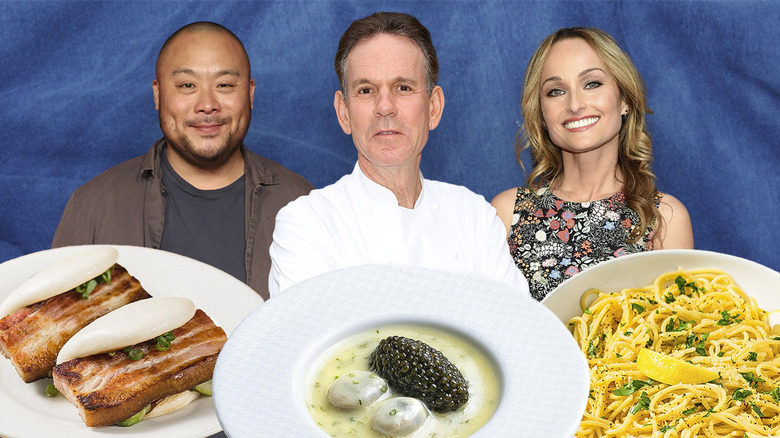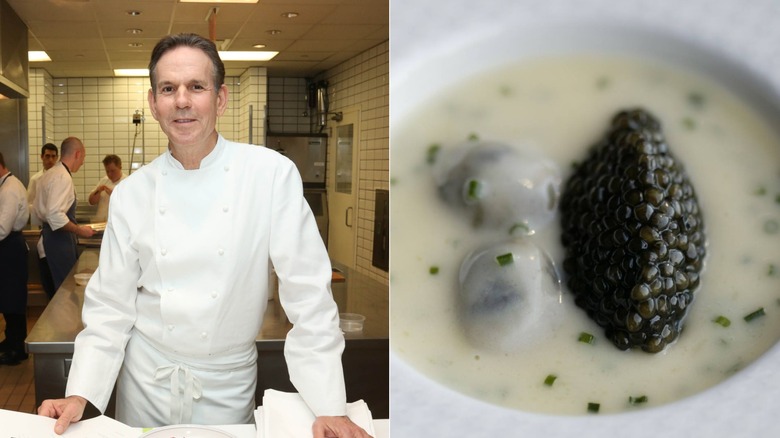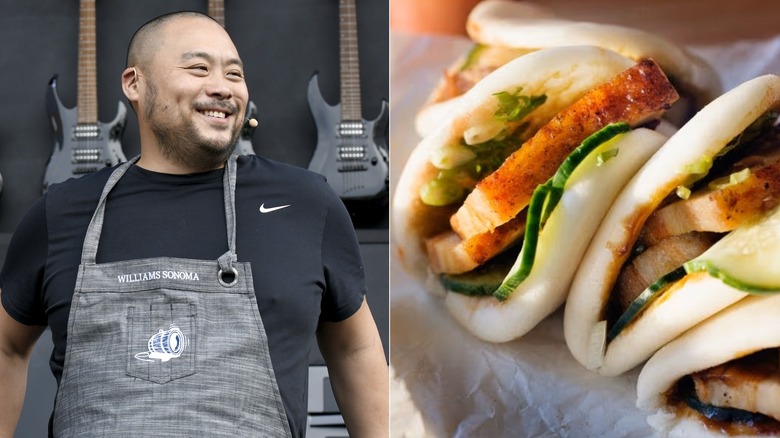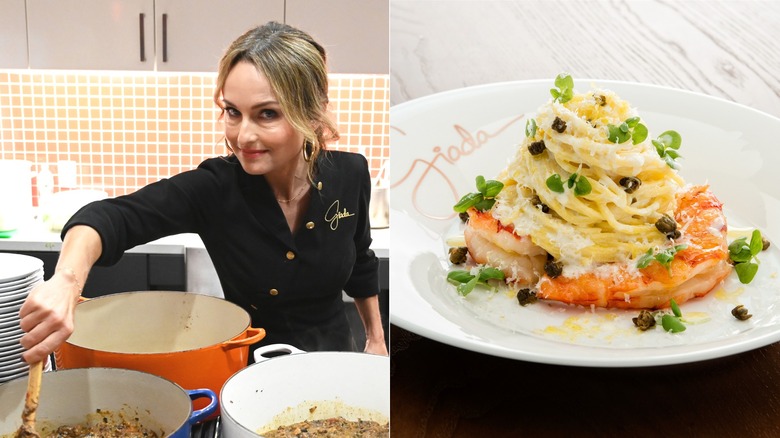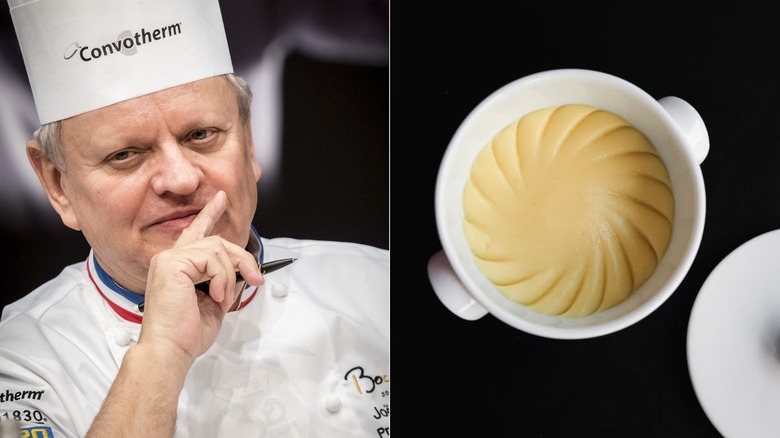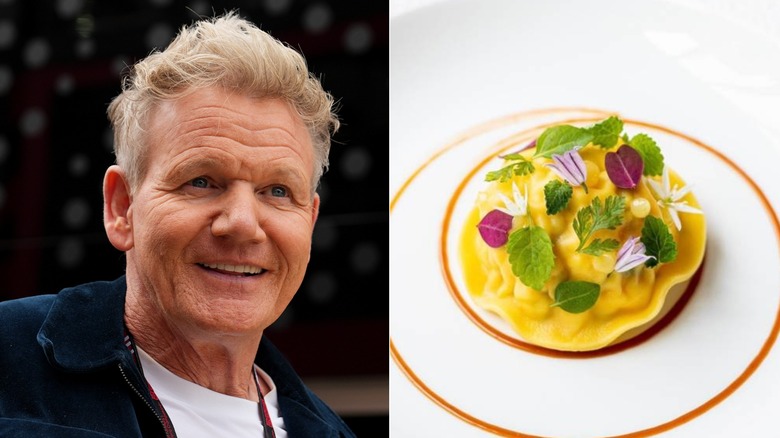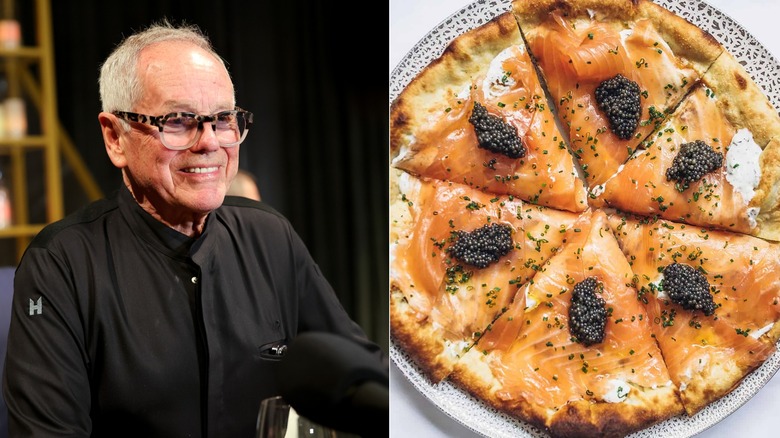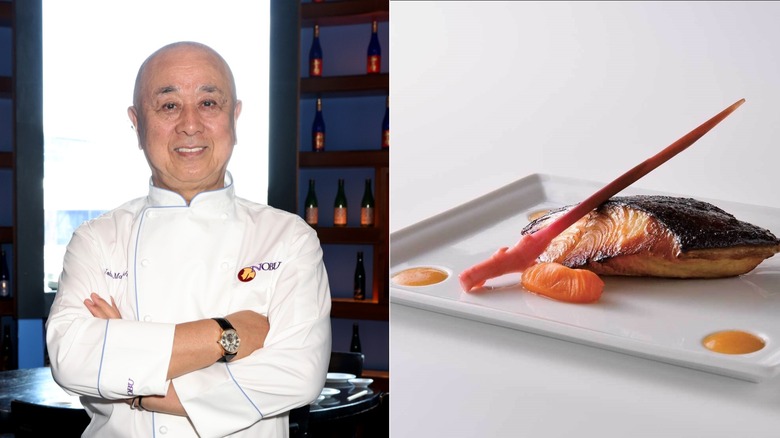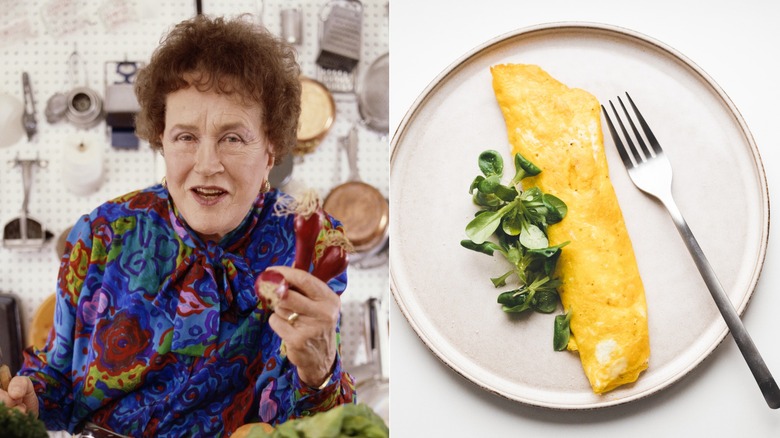10 Dishes That Helped Make These Celebrity Chefs Famous
There are many routes to becoming a successful and world-renowned chef. Some celebrity chefs get their start by writing best-selling cookbooks, while others earn their place in the culinary hall of fame through repeated recognition by the James Beard Foundation or joining the exclusive club of restaurants that have three Michelin stars. In today's media environment, many chefs become a household name by hosting one of the Food Network's popular cooking shows.
What every celebrity chef has in common, though, are their amazing recipes. For some, fame is a combination of a lot of small successes throughout their careers — but for others, there's one defining dish that thrust them into the spotlight and changed their lives forever. You may think you know the dish that catapulted your favorite celebrity chef to success, but the signature dish they're known for today may not be what actually got them noticed all those years ago. Let's dive in to some of the most popular celebrity chefs of our time and the dishes that helped to make them famous ... the answers may surprise you.
Thomas Keller's Oysters and Pearls
Thomas Keller's journey to celebrity chef was anything but straightforward. When he purchased The French Laundry, a mom-and-pop restaurant in Napa Valley, he had already been a professional chef for 20 years. Keller had to scrape together small investments from 52 shareholders to bring his vision of renovating and reimagining the restaurant to life.
When the restaurant reopened with his new French haute cuisine menu, the star of the show was immediately clear: Oysters and Pearls. The combination of savory pearl tapioca, topped with oysters and white sturgeon caviar, represented Keller's unique perspective on bringing together French and American cuisine in imaginative ways.
By 1996, Keller was named Best Chef by the James Beard Foundation. An influential New York Times food critic in 1997 called The French Laundry "the most exciting place to eat in the United States." The restaurant spent multiple years at the top of the 50 Best Restaurants in the World list by UK media company William Reed.
Oysters and Pearls continues to be regarded as a turning point in culinary history, inspiring generations of chefs with a juxtaposition of impeccable technique, classic luxury, and modern whimsy. The dish has been adapted by chefs across the world, and the original composition is still served at The French Laundry to this day, a beacon of Keller's legacy in the culinary world.
David Chang's Pork Buns
Celebrity chef David Chang's culinary breakthrough came in the form of a fairly simple last-minute menu addition that would become unexpectedly legendary: the pork bun. When he opened his first restaurant Momofuku Noodle Bar in 2004, Chang had no idea that New Yorkers would go crazy for his take on a traditional Chinese steamed bun filled with roasted pork belly, hoisin sauce, pickled cucumbers, and scallions. At the time, pork belly was a remarkably unpopular meat in the American culinary scene.
The dish's appeal lies in its perfect balance of textures and flavors: the rich saltiness of the pork, the sweet umami of the hoisin sauce, the crisp acidity of the cucumbers, and the soft milky texture of the bao bun. Though he didn't invent the bun, Chang's version became a cult favorite, inspiring countless imitators and helping to popularize pork buns across the American dining scene.
Today, Chang credits the success of Momofuku and his subsequent career trajectory to this dish. Its success helped launch his global restaurant empire, which later earned Chang a spot on Time magazine's list of the 100 Most Influential People in 2010, and eventually landed him a role presenting the Netflix food series "Ugly Delicious." Chang's reputation for elevating humble traditional Asian dishes and bringing global cuisine to the American culinary stage all begins with the pork bun.
Giada de Laurentiis' Lemon Spaghetti
Giada De Laurentiis' rise to culinary stardom began with her debut Food Network show "Everyday Italian," on which she strived to make Italian cooking accessible to the everyday American home cook. Though she initially caught the attention of Food Network producers with her food styling for a Food & Wine shoot, the dish that put her on the map with viewers and cemented her place in the culinary television hall of fame was Lemon Spaghetti.
Inspired by a visit to Capri in 2003, de Laurentiis' Lemon Spaghetti is deceivingly simple: lemon juice, olive oil, spaghetti, parmesan, and fresh herbs combine to make a fresh and flavorful bite. The dish exemplifies Giada's culinary style of combining California-fresh ingredients and traditional Italian cooking techniques to create her own modern twist on classics that quickly become truly timeless dishes.
Today, lemon spaghetti remains the most ordered item at de Laurentiis' Las Vegas restaurant, GIADA, where it's served with mascarpone cheese and shrimp for an elevated flavor profile. The dish's enduring popularity speaks to the appeal of her culinary philosophy, proving that Italian food can be both sophisticated and accessible.
de Laurentiis' career has since expanded to include numerous cookbooks, restaurants, and television shows, with accolades spanning from The New York Times bestseller lists to the Emmy's. Throughout it all, this signature dish has remained a cornerstone of her success, a bright and flavorful reminder of the moment she first captured America's hearts.
Bobby Flay's Shrimp and Roasted Garlic Tamale
When Bobby Flay opened his first restaurant Mesa Grill in 1991, he introduced New York diners to a bold new vision of Southwestern cuisine. The restaurant's colorful decor, loud music and cowboy-inspired fashions were a divergence from fine dining norms of the time, an apt parallel to the loud and unapologetic flavor that awaited Mesa Grill's diners. The standout dish on that original menu was Flay's Shrimp and Roasted Garlic Tamale, which earned praise from The New York Times food critic who deemed it his favorite.
This signature dish, a tender cornmeal tamale stuffed with juicy shrimp and doused in a creamy garlic sauce, helped establish Mesa Grill as a culinary destination. The restaurant established a buzz that brought Southwest flavors into the fine dining mainstream and positioned Flay as a rising star in the restaurant world. Not long after opening the restaurant, Flay began appearing on culinary television shows like Iron Chef, which would lead him to a long an illustrious career spanning 17 different shows and 18 cookbooks.
The shrimp and roasted garlic tamale remained on the menu at Flay's Mesa Grill in Las Vegas until its closure in 2020, solidifying its legacy as the dish that opened the door to his career as a celebrity chef. Its bold flavors are emblematic of Flay's style and personality that has made him one of the most recognizable faces on the Food Network.
Joël Robuchon's Pommes Puree
Joël Robuchon is one of the most iconic and influential chefs of our time, but his long and illustrious career can be traced back to a simple dish of pommes puree, or mashed potatoes. First served at his debut restaurant Jamin in the heart of Paris in 1981, this take on a simple classic sent shockwaves through the culinary world and is still the most famous version of celebrity chef mashed potatoes to exist.
At the time, it was almost unheard of for fine cuisine to include potatoes, which were considered a poor man's vegetable. Robuchon, however, had a tendency to romanticize simplicity when it came to his dishes, never using more than three or four ingredients. By combining just four components (potatoes, butter, milk, and salt), with a complex and refined technique, Robuchon was able to elevate this humble ingredient into a creamy, airy delicacy that changed the food world forever.
Robuchon once said of the dish, "I owe everything to these mashed potatoes." The pommes puree launched a career that saw Robuchon crowned as "chef of the century" by French guide Gault-Millau, earned him the most Michelin stars ever held by a chef of his time, and made him an inspiration to the culinary world, including many of the celebrity chefs who would follow in his footsteps. Today, the pommes puree is still served worldwide at his legendary L'Atelier restaurants, allowing new generations of foodies to get a taste of his legacy.
Gordon Ramsay's Lobster Ravioli
Though culinary mega-celebrity Gordon Ramsay is commonly associated with the Beef Wellington, the dish that actually first brought him critical acclaim was his Lobster Ravioli. He originally learned and developed the recipe while working under Marco Pierre White at the legendary London restaurant Aubergine. When Ramsay opened his own flagship Restaurant Gordon Ramsay in Chelsea in 1998, the lobster ravioli was one of the first dishes on the menu.
The dish is a study in resourceful luxury. By using less-desirable parts of the lobster, like knuckles, claws and legs, Ramsay's ravioli elevates an otherwise overlooked delicacy by pureeing it into a mousse with langoustine and salmon. This mixture is then wrapped in a delicate pasta shell and served with a slightly sweet tomato chutney and drizzle of decadent lobster vinaigrette. Anthony Bourdain once described Ramsay's ravioli as "God's work." The dish requires a high level of finesse, which makes sense because Ramsay was mentored by Joel Robuchon, who was known for his impeccable technique.
Today, Ramsay is one of the most recognizable names in the culinary world, holding seven Michelin stars and appearing on TVs everywhere in shows like "Master Chef" and "Kitchen Nightmares." He has critically acclaimed restaurants in the United States, Singapore, France, China, the U.K. and beyond. Lobster Ravioli remains a signature dish at his three-Michelin-star Restaurant Gordon Ramsay to this day, underlining its contribution to Ramsay's reputation for food that's inventive, elegant, and technically flawless.
Wolfgang Puck's Smoked Salmon Pizza
Wolfgang Puck is credited with being one of the trailblazers of California cuisine — a culinary revolution in the 1970's and '80's that brought us California rolls, Cobb salad, and California-style pizza. Puck's influence on the latter began with a dish that would become synonymous with his success: the smoked salmon pizza.
Puck was already a rising star in the culinary scene when he opened his first restaurant, Spago, in West Hollywood in 1982. The dish that catapulted him to international acclaim came just a year later, by happenstance. Puck happened to be out of brioche when a well-known actress ordered the brioche and salmon dish from his menu. Unwilling to disappoint her, he quickly added the salmon with crème fraîche to a freshly baked pizza crust, topping it with caviar.
At the time, pizza wasn't considered fine dining. Puck redefined this dish in the California cuisine style, using high-end ingredients and worldly flavors, and word spread fast. The smoked salmon pizza was soon being replicated around the world as "Spago Pizza" and inspiring a new generation of elevated pizza dishes.
The success of Spago allowed Puck to launch his television career, first appearing on "Good Morning America" in 1986. Several James Beard awards, a few Michelin stars, seven cookbooks and five seasons of his own show, "Wolfgang Puck's Cooking Class," would follow. Today, smoked salmon pizza is still served at Spago and remains one of the most iconic items on the menu.
Nobu Matsuhisa's Miso Marinated Black Cod
Nobu Matsuhisa is a global name in fine dining, with eponymous Nobu restaurant locations all over the world. But in 1994, when he opened the flagship location in New York, he wasn't a household name yet. It was one item from his original menu that would propel him into the spotlight and launch a now-iconic brand: the miso-glazed black cod.
In the early days of Nobu, the miso black cod quickly became one of the standout items that drew praise from critics and diners alike. The dish is fairly simple, but time and technique lend complexity to its flavor. Black cod is marinated for days in a mixture of white miso, sake, and sugar, then broiled until the glaze caramelizes and the fish is fall-apart tender. Its unique blend of salty, sweet, and umami flavors helped introduce a generation of American diners to Japanese flavors in an approachable way, at a time when many were hesitant to try the foreign delicacy of raw fish.
Today, miso cod remains one of the most popular dishes at Nobu restaurants around the world. It's also featured prominently in Matsuhisa's 2025 biographical documentary, a nod to the role it played in launching his global empire. For many, it's their unforgettable first taste of Nobu's signature style, bringing Japanese flavors to the masses with more accessible ingredients.
Julia Child's French Omelet
Julia Child is credited with making French cuisine accessible to American home cooks, but her rise to fame didn't begin with boeuf bourguignon or coq au vin — it started with a simple omelet. While promoting her now-legendary cookbook "Mastering the Art of French Cooking" on a local Massachusetts TV program in 1962, Child demonstrated how to make a classic French omelet. Her approachable warmth and wry humor immediately resonated with viewers. The response was so enthusiastic that she was offered her own show, "The French Chef," which would go on to make her one of the first true celebrity chefs in America.
The omelet itself was simple: eggs, butter, and a quick-cooking technique. Still, it captured everything that made Child a beloved American culinary figure. She welcomed America into her kitchen, showed them the beauty and joy of French cuisine, and encouraged home cooks to try things they might have thought were too difficult.
Child's French omelet demonstration became one of the first recipes aired on "The French Chef." While sometimes outshined by her other, more complex recipes, this omelet is a tried and true classic that stands the test of time. It represents a true turning point in American culinary history and the unforgettable impact of Child on the future of American food and entertainment.
Emeril Lagasse's New Orleans BBQ Shrimp
Emeril Lagasse made a name for himself developing his "New New Orleans" style as executive chef at the legendary New Orleans restaurant Commander's Palace, but it wasn't until he opened his own restaurant Emeril's in 1990 that his career truly took off. One of the first dishes on the menu, and still the most requested more than 25 years later, is his elevated take on the classic Cajun dish of BBQ shrimp.
Lagasse's version of the dish is rich and flavorful, made with jumbo Gulf shrimp sautéed in a buttery Worcestershire sauce with garlic, black pepper, and Creole spices. It's served with a side French bread for scooping up every last drop of sauce. "BBQ Shrimp is a very New Orleans dish, but pretty messy," Emeril told People, referring to the dish's traditional serving style, which involves peel-on shrimp eaten with the hands. "I wanted to give my customers the great flavor of this dish but suited for a white tablecloth fine dining restaurant."
That's exactly why this dish is so emblematic of Emeril's style — traditional New Orleans fare, elevated and refined. Lagasse's interpretation of the classics helped usher in a new era of Louisiana cuisine and spotlighted New Orleans on the world culinary stage.
It wasn't only New Orleans that was getting the spotlight, though. The popularity of the BBQ shrimp dish at Emeril's helped catch the attention of Food Network producers, eventually leading to Lagasse's breakout television career. With shows like "Emeril Live" and "Essence of Emeril," he became one of the first chefs to turn cooking into pure entertainment, complete with catchphrases and a live audience. Though Lagasse has joined the cast of '90's celebrity chefs who faded from the spotlight, his legacy lives on in his signature dish.
